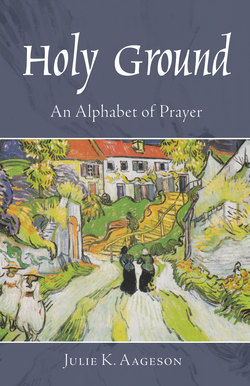Читать книгу Holy Ground - Julie K. Aageson - Страница 10
На сайте Литреса книга снята с продажи.
Beauty
Оглавление“Earth is crammed with heaven and every common bush afire with God.” Oh, Elizabeth Barrett Browning, how many times we’ve repeated your poetry and imagined ourselves in the lush green English countryside of your beautiful world. How many times your words have reminded us to pay attention to the beauty of our earth home, our own holy ground. Perhaps we have it backwards when we think of heaven as a place “out there.” Swiss psychiatrist and psychoanalyst Carl Jung invites us to think of heaven and earth as a piece—the earth is in heaven. Human and spirit are not divided. Earth and heaven are one. Without ignoring or minimizing the brokenness and unspeakable suffering of our world, the beauty of this place we call home is among the most tangible ways we understand God.
Not long ago, my spouse and I spent an evening on the top of a mountain pass. Driving the long and circuitous road to get to the top of the pass, we watched the slow setting of the sun and the shadows of the mountains surrounding us as they slowly turned shades of rose and purple and then inky black. Finally darkness came and from the south we could see the international space station in its orbit, moving around the earth every ninety minutes. As it passed overhead, more and more stars began to appear and we could make out constellations and the obvious formations of the Big Dipper and Cassiopeia with its distinctive W shape. As midnight approached and the light of the western sky turned completely dark, our own Milky Way Galaxy began to show its unfathomable size and beauty just overhead. Through telescopes, we could see other galaxies including Andromeda as well as dying stars and “shooting stars” and stars just being born. Most of all, we gazed with wonder at the heavens above us and at the stars and planets and galaxies that silently blossomed across the fields of the night sky. In the stillness and awe of that night, we truly understood the earth to be in heaven.
The ancients lived in a world of daylight and darkness. Without artificial light and the endless daytime of our era in history, they experienced the wonder of the night and perhaps the humility of looking out into the cosmos that shaped their universe. They made gods of the stars and depended on their stories about them for making sense of daily life. I want to think about the extraordinary beauty of the universe as a way of speaking with God and sharing God’s generativity and grace.
In the places where I live, we are surrounded by astonishing natural beauty. Ocean beaches and coastal mountain ranges, river gorges and volcanic peaks, endless varieties of flora and fauna, desert and forest, glacial lakes and craggy mountain foothills—none of which ever grows old. The beauty in these places is mind-boggling. My grandfather called this part of the world “Shangri-la”—his way of setting it apart and labeling it “earth crammed with heaven.” Poetry and music, photography and painting don’t begin to do justice to this handiwork of creation. Here in this place I find God’s sacred presence and a sense of the wonder of my own life. In the places where I live and share the everyday ordinary rhythms of daily life, I see and hear and taste God’s presence. Prayer indeed.
But of course there is beauty everywhere and each of us experiences beauty in thousands of different ways. Among the broken shards of the Gaza Strip, in the midst of hunger and water shortages and the unrelenting dehumanizing of the Palestinian people, a young shepherd boy plays a violin as he, like the pied piper he imagines himself to be, leads a flock of sheep out of the hills and back to their ragged and rocky stalls before the coming of night. In Aleppo and Paris and Beirut and Manchester, there is beauty in the faces of first responders and doctors and all those who risk their own lives to help others caught in cycles of violence and despair.
We pay attention to beauty as a way of praying. On Facebook recently, a friend posted a photo of an early morning sunrise. The picture was titled, “Begin with yes” reminding me of a reflection by twentieth-century psychiatrist Viktor Frankl. Frankl described being at work in a trench, the ravages of war dark and broken all around him. As he struggled to find the reason for such suffering and hopelessness, he sensed his spirit piercing through the gloom with a resounding yes in the face of what seemed to be a meaningless world. At the same time, a light came on in a distant farmhouse on the gray horizon affirming Frankl’s yes, affirming God’s yes.
O God, let us pray with eyes to see beauty and ears to hear music. Let us pray with our hands and our hearts so that beauty is not only what you give but what we make.
REFLECTION
Most of all, we gazed with wonder at the heavens above us and at the stars and planets and galaxies that silently blossomed across the fields of the night sky—prayer indeed.
In the stillness and awe of that night, we truly understood the earth to be in heaven. How do you experience earth and heaven as one?
To find beauty in the midst of horror and death seems strange. Yet Viktor Frankl’s yes is an affirmation of God’s presence in spite of so much darkness and suffering. What does it mean to you to begin with yes?
Without ignoring or minimizing the brokenness and unspeakable suffering of our world, the beauty of this place we call home is among the most tangible ways we understand God. How is paying attention to beauty a way of praying for you?
Compassion
